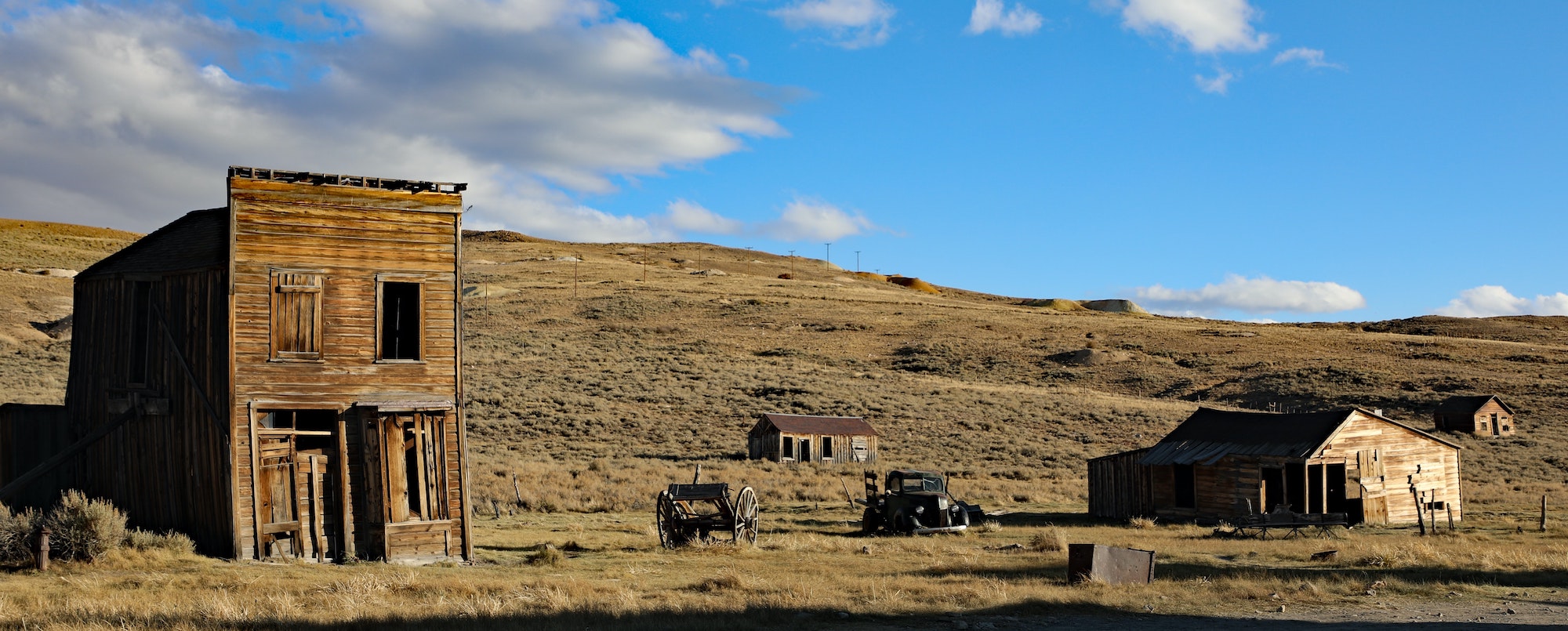How I Finally Ditched Evernote for Joplin
I signed up for Evernote like 15 years ago, first for the free plan and then I paid for it when it started nagging me. I already had so much in there. At the time, it was one of the first two services I paid for. The other was Dropbox. And in the last 15 years, I have only added Medium, Netflix, LastPass, and Amazon Prime to my subscriptions.
I hate subscriptions and for each one I have a step by step process in a Evernote (now Joplin) note to cancel them when I need to. Also the credit card they’re billed to so I cancel the whole card if I need to because I have done that.
Subscriptions are free rides for these companies. A lot of people forget they subscribed, hardly ever use the services, and the tech companies like keeping that going by making it as hard as possible to cancel.
Evernote is not that expensive, though I think the price doubled this year from $60 a year to $120. I was charged that two weeks before I made the change. But that was not why I canceled.
Table of Contents
- Reasons I Finally Moved from Evernote to Joplin
- How to Migrate from Evernote to Joplin
- Joplin Plugins and Other Features You Should Know About
- How I Use Joplin with Obsidian
- How I Plan to Nip Digital Hoarding in the Bud
- Conclusion: Joplin vs Evernote
Reasons I Finally Moved from Evernote to Joplin
I finally cancelled Evernote because I have been meaning to for a while, for a few reasons:
- I don’t own my notes. I have to open an Evernote app in order to read or create them.
- Exporting is a pain if you do want access other than through an Evernote app.
- I’ve gotten used to markdown and I would prefer everything that can be in markdown to be in markdown so I don’t have to worry about weird formatting issues or converting notes from one format to another.
I actually have tried to migrate a few times already to various other apps like Notion, but once I started, I knew it was going to take some time so I rolled back and waited until I did research the best alternative to Evernote for me.
In the meantime a few other things began to piss me off about Evernote:
- When I click a url in my note, I want to go there, not login first. That’s why I put it there. For convenience. Why block me?
- Skitch stopped working right on the new Macs.
The Skitch issue wasn’t the straw that broke the camel’s back. It was more like I realized I had a problem with hoarding and when Skitch stopped working, I went to a screenshot app that didn’t save to Evernote.
The last time I tried to leave Evernote, my Skitch notebook had over 2000 screenshots in it and I decided to clear those out before migrating. Not fun and takes forever if you are trying to save some of them. When Skitch stopped working, I just deleted the whole Skitch notebook and I realized the rest of my notes would be much easier to migrate.
How to Migrate from Evernote to Joplin
You might wonder why I am migrating my Evernote note to Joplin, instead of these other options:
- Migrating from Evernote to Notion: Again the problem of owning my notes locally somewhere I can access them in whatever way I prefer and have access to the contents without an app.
- Migrating from Evernote to Obsidian: I do use Obsidian but not for random clips, notes, and todo lists. I have Obsidian vaults for specific things like my writing or my science fiction research. What I store in Evernote/Joplin is web clips, process checklists that I use over and over, and unorganized research. It is kind of my digital junk drawer. But now that I do use Joplin, its easy for me to drop vetted notes into a new notebook and export that whole notebook ready for use into Obsidian, which I will explain later.
One thing I new my new note tool needed was the ability to clip from the browser and mobile apps and Joplin has both. Here is the process I used to migrate to Joplin:
Cleanup and Reorganize First
This is where the digital hoarding ends. I didn’t want to move everything. Because Skitch already stopped working, I didn’t have to worry about sorting through all of that. I just deleted the notebook. But I still had over a dozen other notebooks, so I consolidated some of them and deleted others that were just hanging out.
You don’t have to do this, but you will find out why it’s a good idea in the next step.
Export Each Notebook Separately from the Desktop App
Believe me, I looked for ways around this, but it seems to be the only way and I only found the option on the desktop app. So for each Evernote notebook you want to export for Joplin, you’ll have to right click on the notebook (stacks won’t work) and click Export notebook:
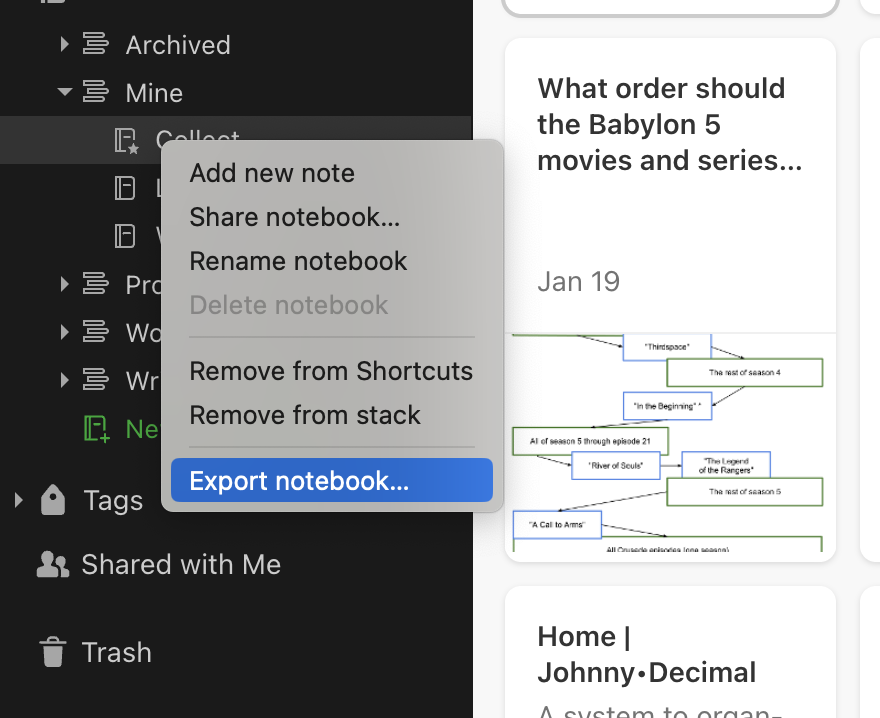
Then choose the ENEX format option and click Export:
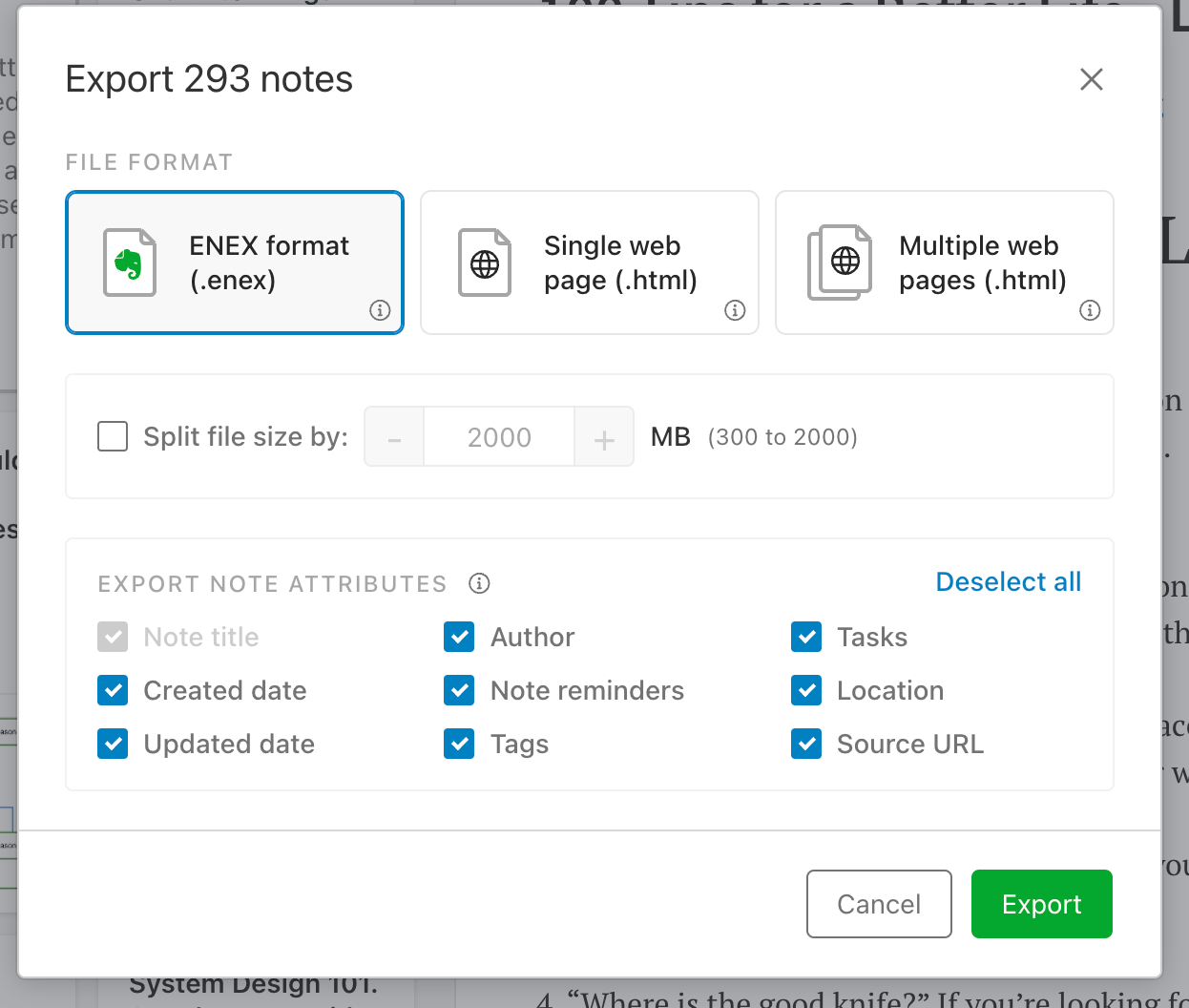
I saved all of these exports to the same folder just in case I made mistakes with the import, but it all went pretty smoothly.
Import Evernote ENEX Files into Joplin
Once you have all the ENEX files you ever wanted, it’s time to import them into Joplin. Go to File>Import>ENEX - Evernote Export File (as Markdown) and choose one of the ENEX files you exported from Evernote.
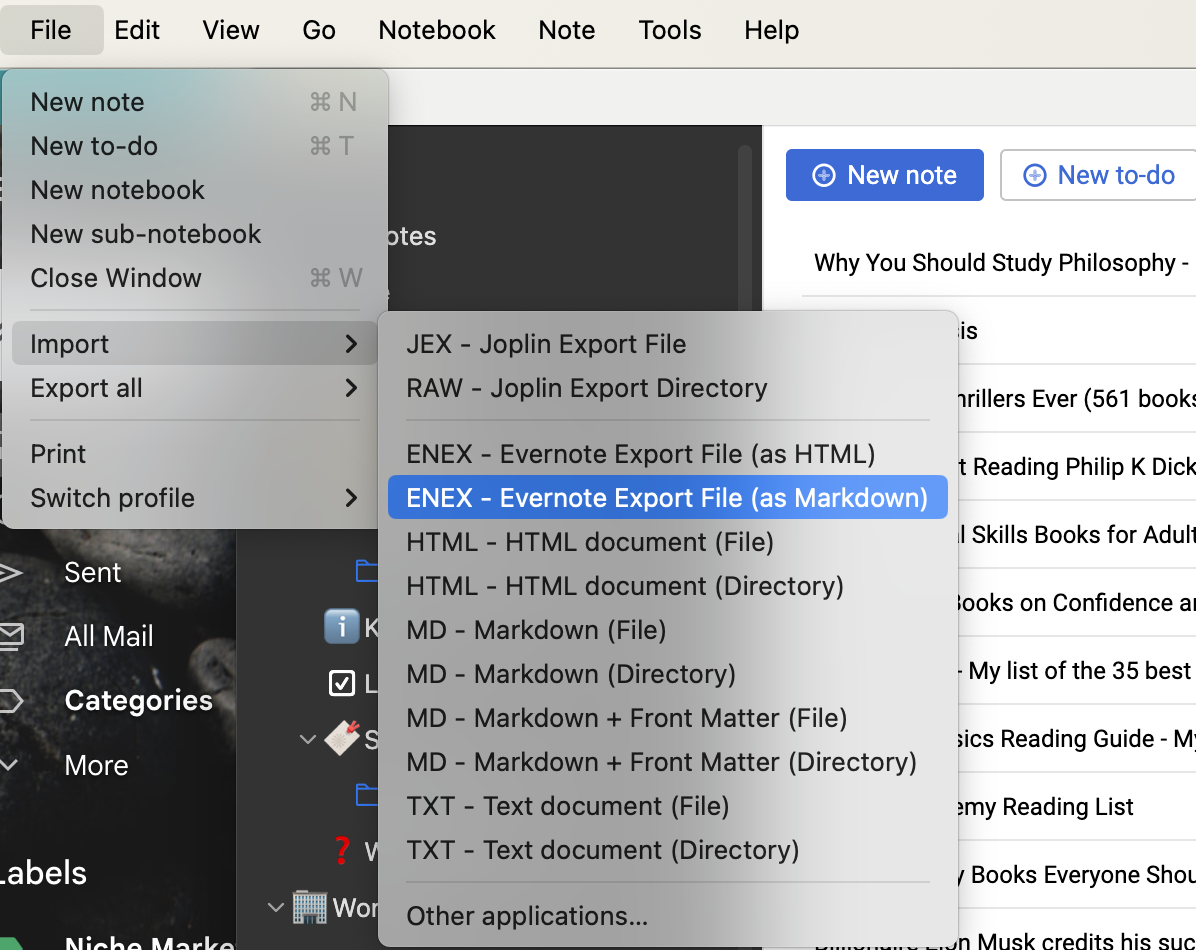
This will create a notebook in Joplin with the same name as the notebook in Evernote with all the notes. And, yes, you will have to do each one separately. I kept worrying I’d accidentally select the HTML instead of the Markdown option.
Don’t worry right now if you had everything organized in stacks in Evernote and now your notebooks are spread all around. We can fix that later because you know what’s better than stacks? Infinitely nested notebooks.
Setup Up the Web Clipper
Joplin has a decent web clipper. I haven’t had any issues with it, but it does take a two-step process to setup. First install the clipper in your browser:
Then go to Settings in Joplin:
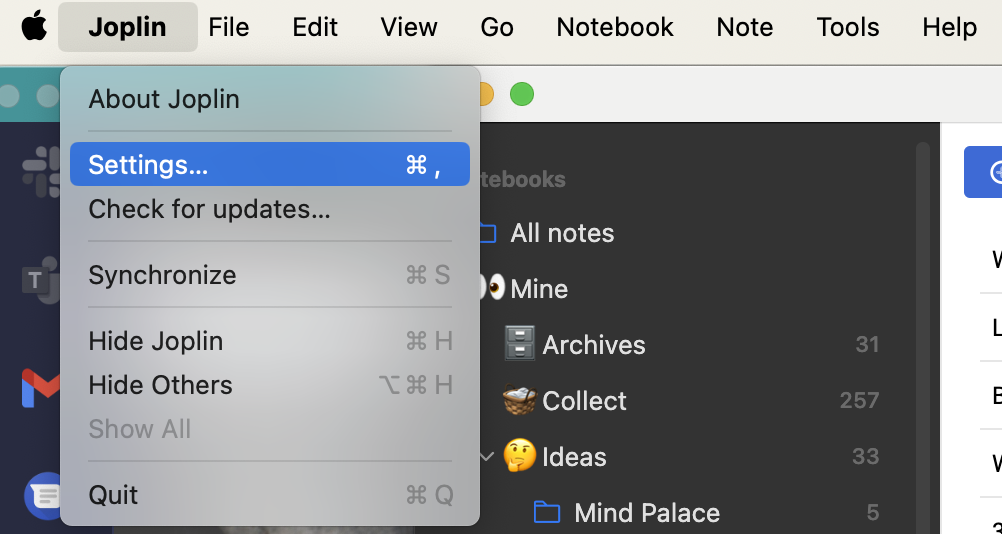
And click on Enable Web Clipper Service:
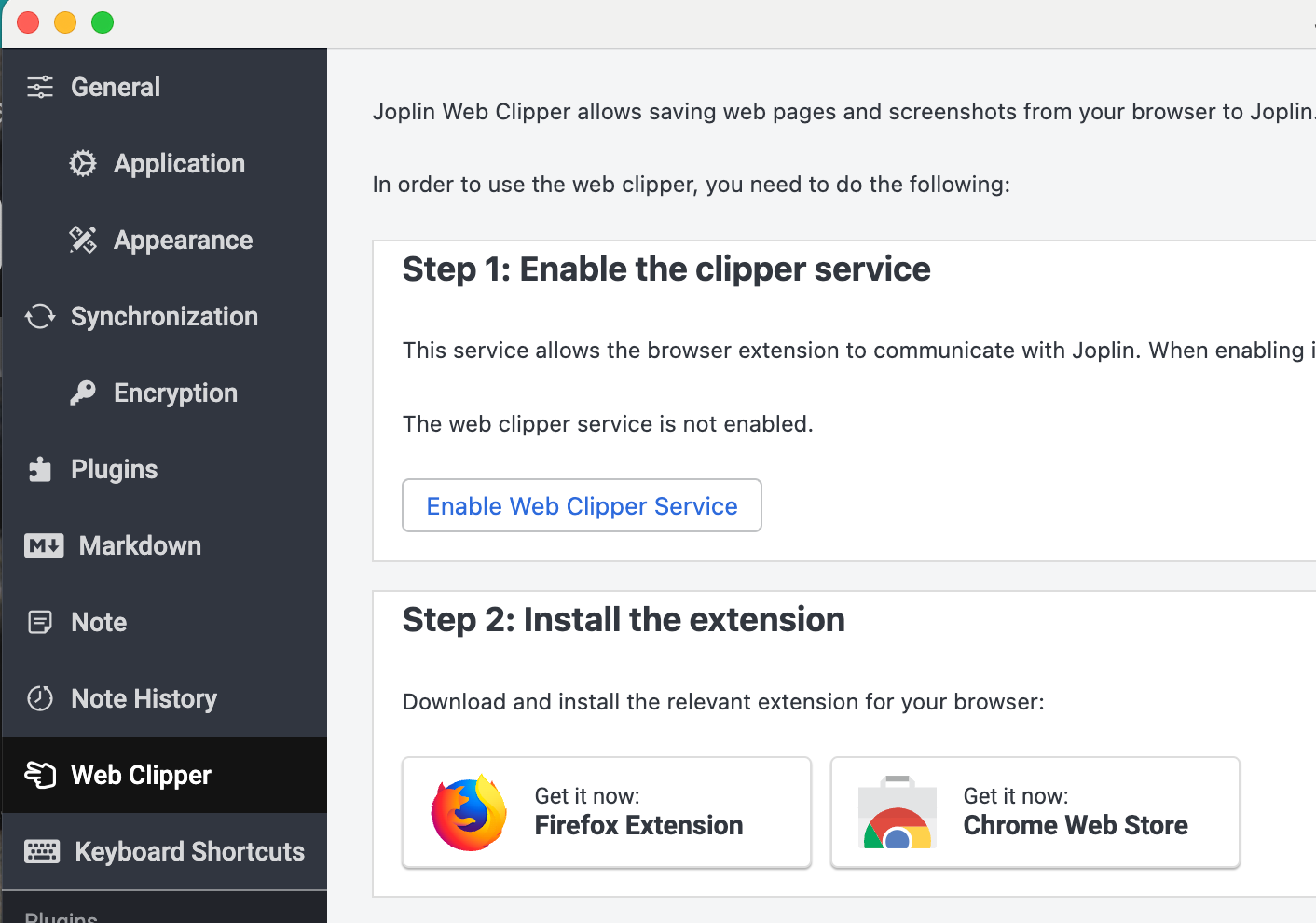
The Joplin Web Clipper gives you quite a few options and will remember the last notebook you used for the next clip:
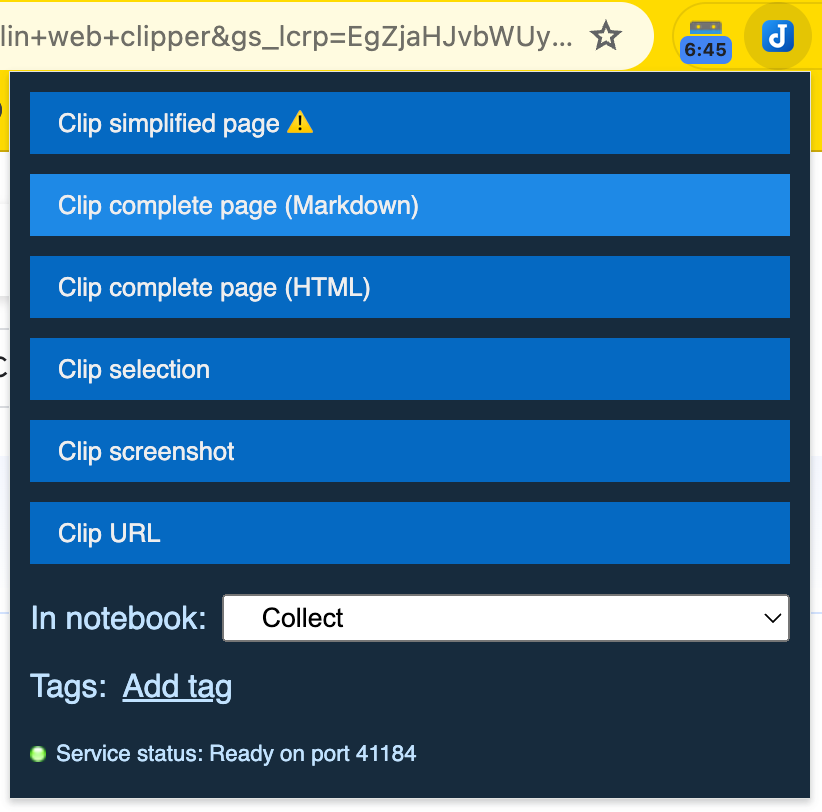
Set Up Syncing
This process is not as smooth as some apps that just let you click a button and then another button and maybe another buttons. Open Settings again and go to Syncronization:
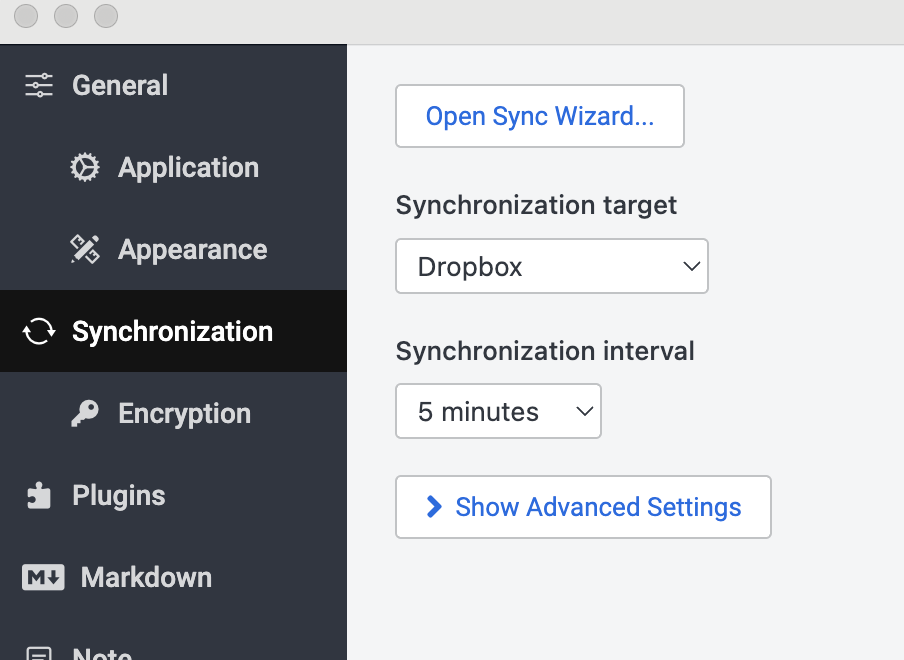
I am syncing my notebooks with Dropbox and if you are using Dropbox, Joplin Cloud, or OneDrive, click on Open Sync Wizard and choose your service:

You can also sync to NextCloud, WebDAV, S3 or Joplin Server by choosing the option from the Synchronization target dropdown:

If you choose Dropbox like me, selecting Dropbox from the wizard will take you here. Click on the Dropbox link:
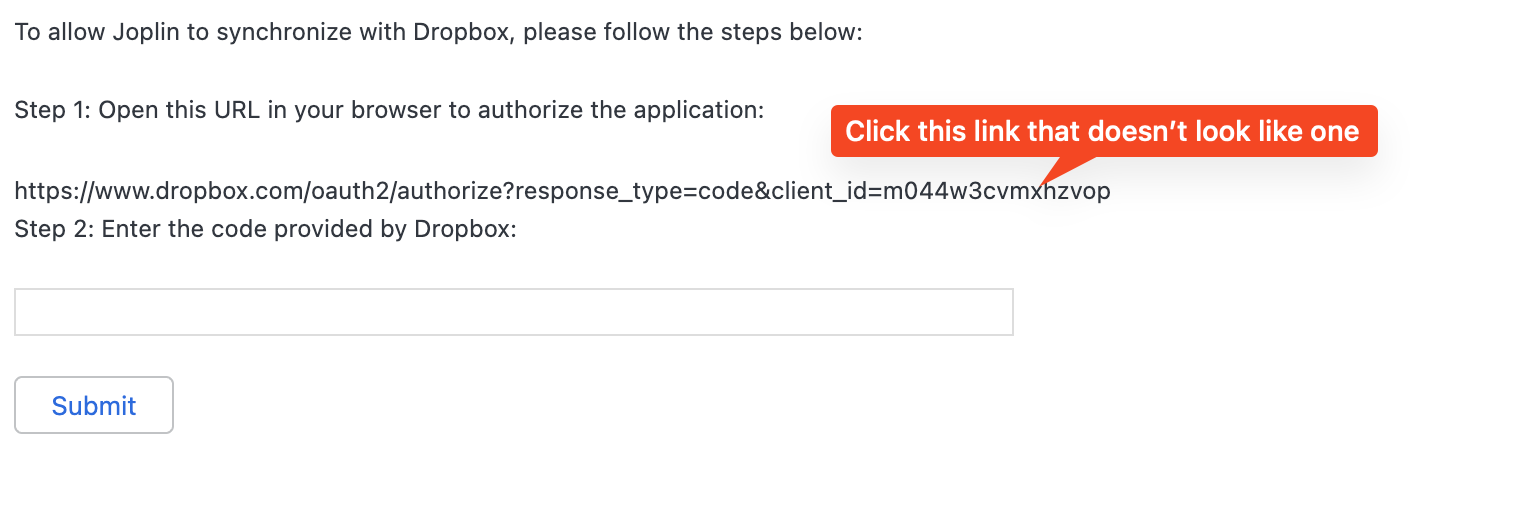
Clicking that link will take you to the web to authorize Joplin access to Dropbox:
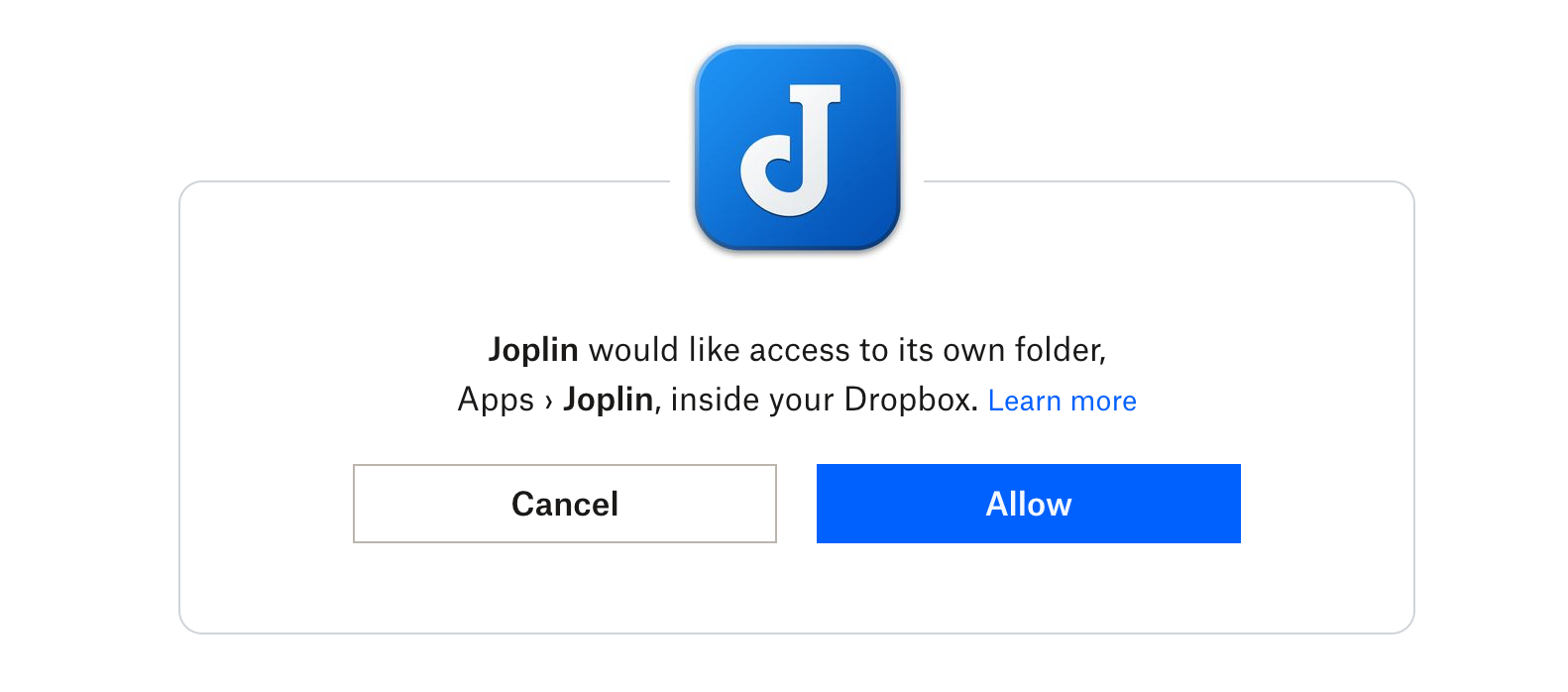
Once you click Allow you will be given a code to paste back into the form in Joplin:
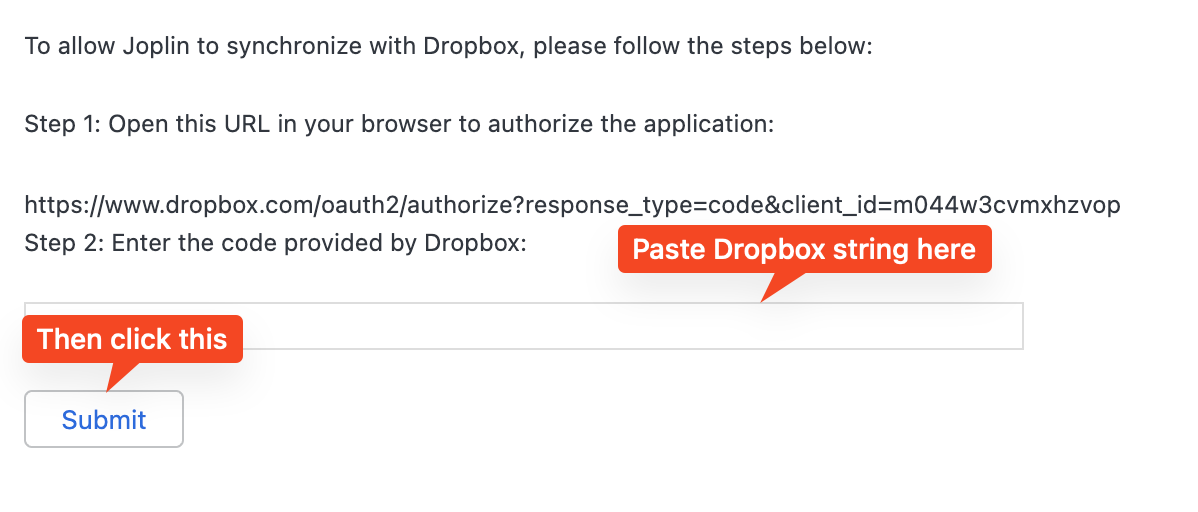
Once you click Submityou will be able to sync to Dropbox. You can choose the Syncronization interval from the dropdown in settings. Five minutes is the minimum and 24 hours is the maximum. You can also choose to disable automatic synchronization if you would rather do it manually.
Install the Mobile Apps
I have both an Android phone and an iPad Pro. Why? Because I hate iPhones and will never get one, but for reading when you have thousands of ebooks nothing beats the iPad and I liked the pen, the 1 TB of storage, and the battery that lasts me for a week of reading without charging.
There is really nothing special here.
- Install the app for Android or iOS.
- Click on the hamburger menu on the left side of the app.
- Scroll to the bottom and choose
Configuration. - In the
Configurationpage, choose yourSynchronization target. - Follow the same steps to authorize your cloud service as you did on the desktop.
Depending on your phone and the amount of notes you have, synchronization could take a while and there could be some issues, because, well, they’re phones and they’re stupid, but I will address those in the next section.
Issues I Had
There are always issues with any type of migration, but after I learned more about Joplin, most of the issues ended up being minor. Some were not real issues at all and I will get to those in the next section.
- Android going to sleep before everything syncs: This was kind of the worse issue. Turned on developer mode and told my phone to stay awake while charging. Worked before. For some reason it didn’t this time and after I went through all the trouble of activating developer mode with the secret decoder ring. Finally I found Caffeine and that worked for me.
- Cannot acquire sync lock: At the time I was syncing Joplin to three apps which was probably the cause. I ran into this and various other errors about sync lock. I fixed this by going to the
locksfolder in myDropbox/Apps/Joplinfolder, which is where it was syncing and deleting every json file in it. The first time I made a backup of the Joplin folder, but it worked, so after that I just deleted the files again if it happened. - Syncing timeouts on large attachments: With Dropbox, it uses the Dropbox API and I am guessing there is an issue there, but it was only one PDF file that was like 100 MB, so I deleted it. This is not as easy as it seems, but here is how. The error with give you a string like
0a84f642d4fa8f2f3b2b789be20a1eb6. Take this string and search the.resourcesfolder in the folder you sync Joplin to. For me it wasDropbox/Apps/Joplin. I found the file with the same string and deleted it and syncing went fine after that.
I also had some issues with how Joplin does things, but can work around them:
- Why can’t Joplin use a folder of markdown files directly like Obsidian? Yes, I can access the files as markdown in the sync folder and if I edit those files, they will sync back to all the apps. But why that way?
- Why not use front matter in the markdown? Instead the data connected to the file is at the bottom of the file like this (but you can still export your notes with front matter):
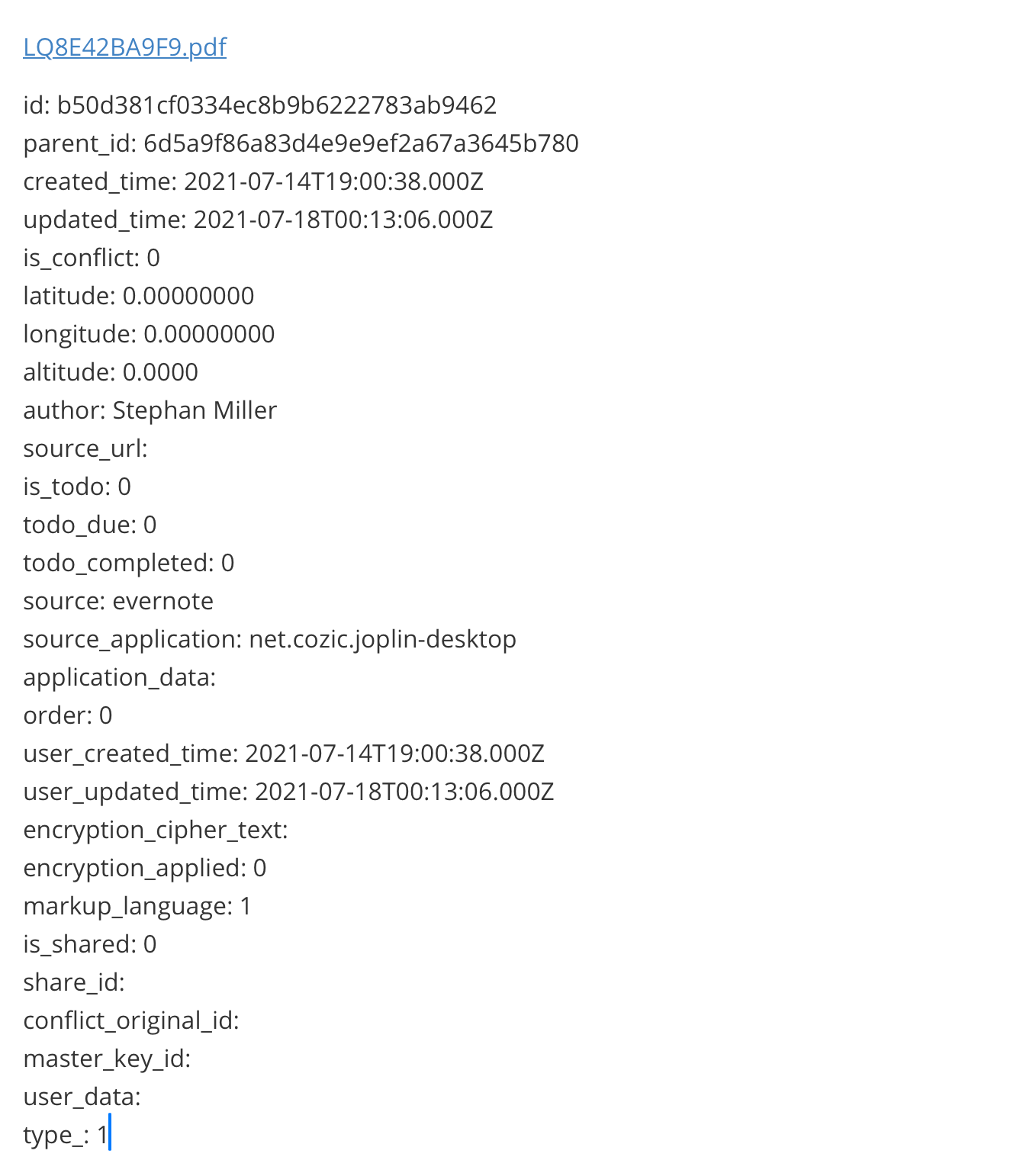
Joplin Plugins and Other Features You Should Know About
When I decided it was time to switch, I had figured I had settled, but was ready. The Joplin UI is pretty basic and didn’t have much features, but I didn’t care. It turns out, I didn’t do enough research. Here are some things I discovered as I started using it that made things better.
I will be referring to some Joplin plugins which you can find listed here. To install them, just find them on the site, then go to Settings > Plugins and search for them by name and click the Install button and then restart to enable it:

Why Does Joplin’s Editor Content Not Fill the Screen?
I full-screened Joplin and the editable area stayed the same size. I finally tracked it down to Settings > General > Appearance and the Editor maximum width setting which is set to 600 by default. I set it 0 so that it takes all the screen space it is given.
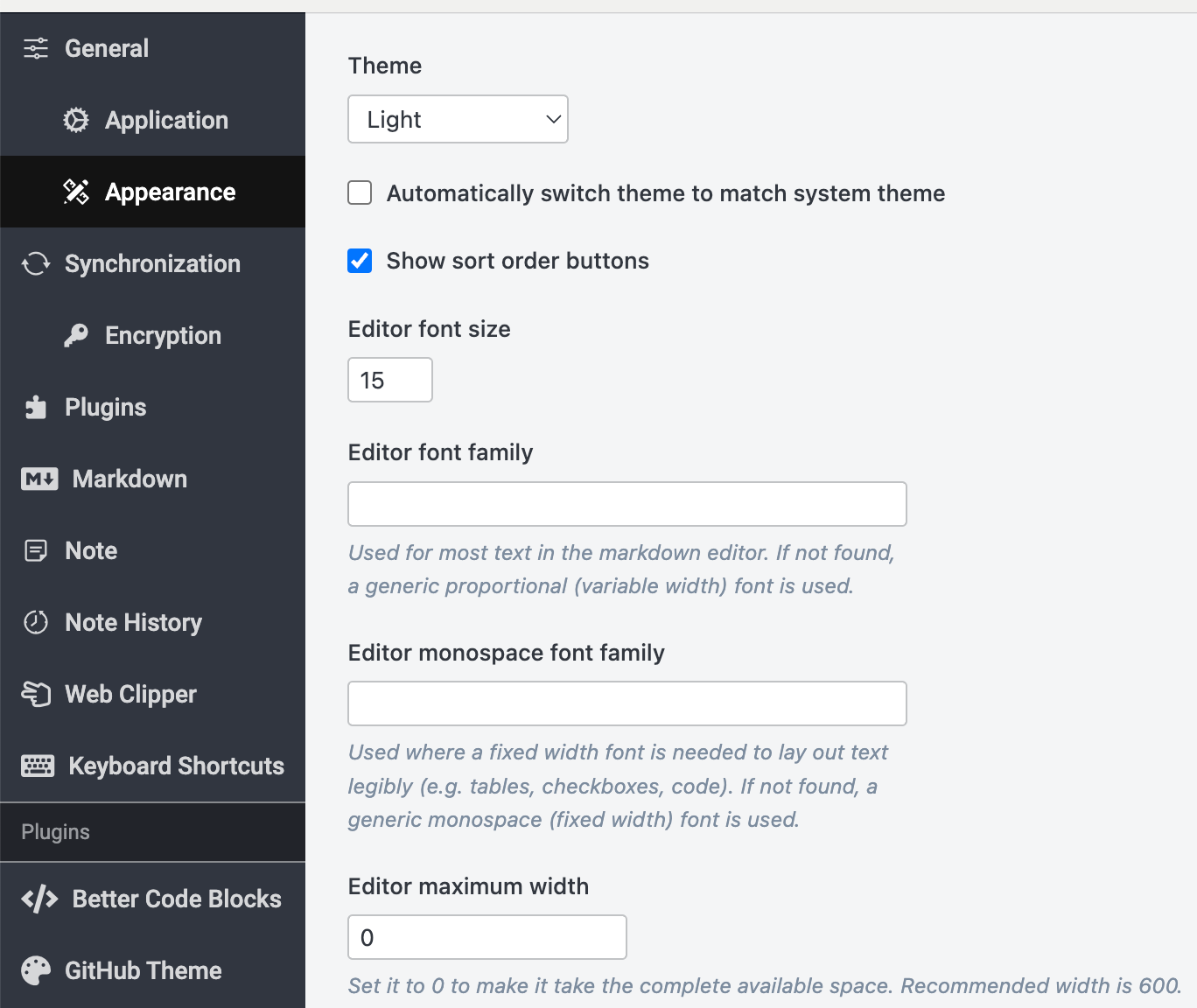
How do I Create Stacks in Joplin?
You don’t. You just create notebooks that can be nested infinitely as far as I can tell. Just drag and drop them around.
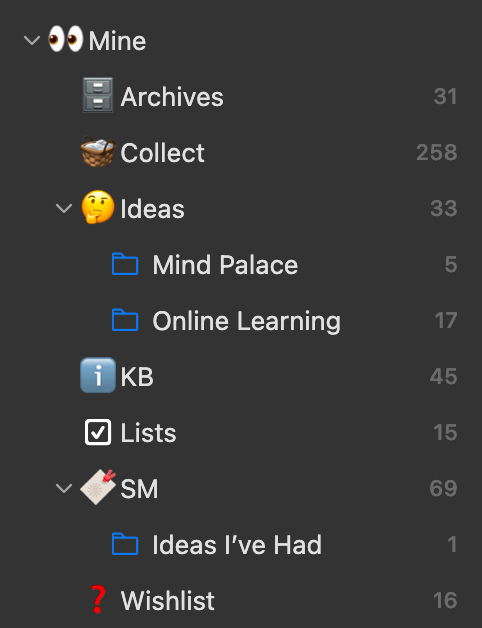
Why Can’t I Just Edit and View a Note in the Same Panel in Joplin?
You can. You just need to add the plugin. Without it, you get a split screen view with the markdown on one side and the rendered file on the other. I hate that. The Rich Markdown plugin will solve that problem.
How Can I Distinguish One Notebook from Another Visually?
Right click on the notebook and choose Edit. In the menu that pops up, you can change the name of the notebook, but you can also choose an emoji or select an image file from your local file system as an icon for that folder. I found this by accident editing a notebook name.
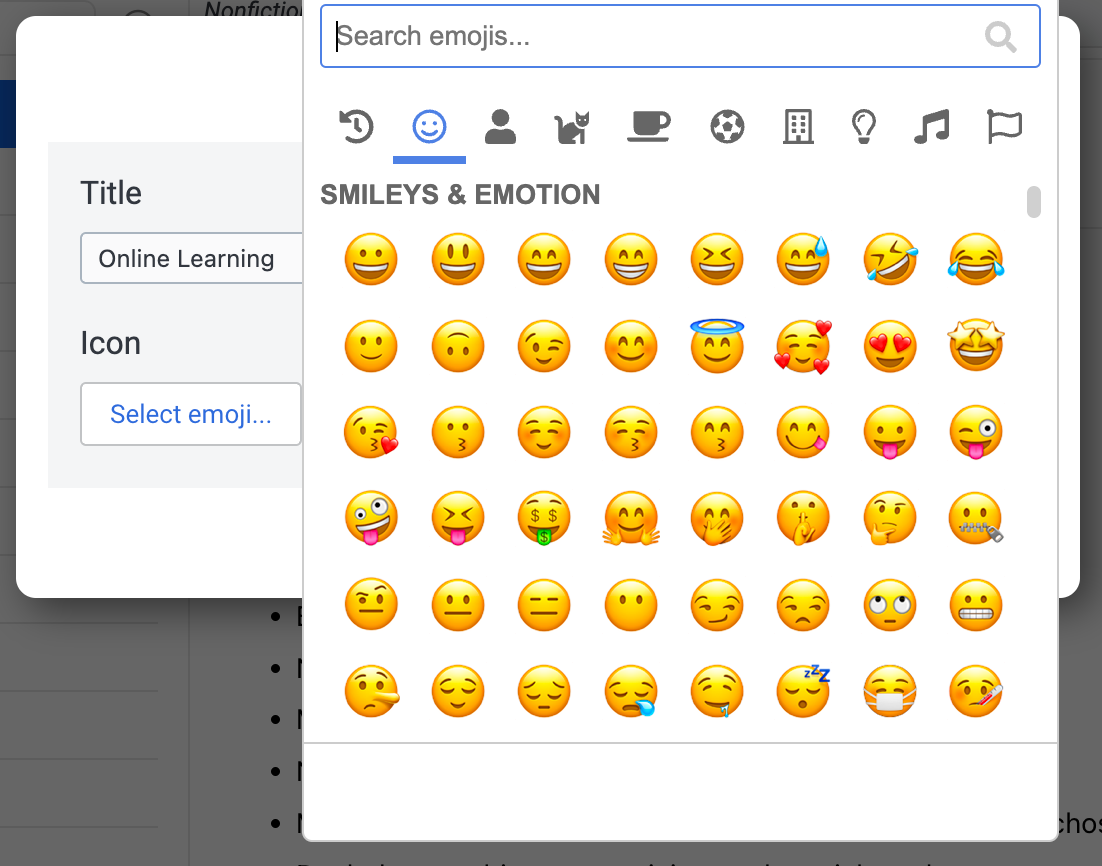
How Do I Change the Theme?
You can set a few settings with the default theme:
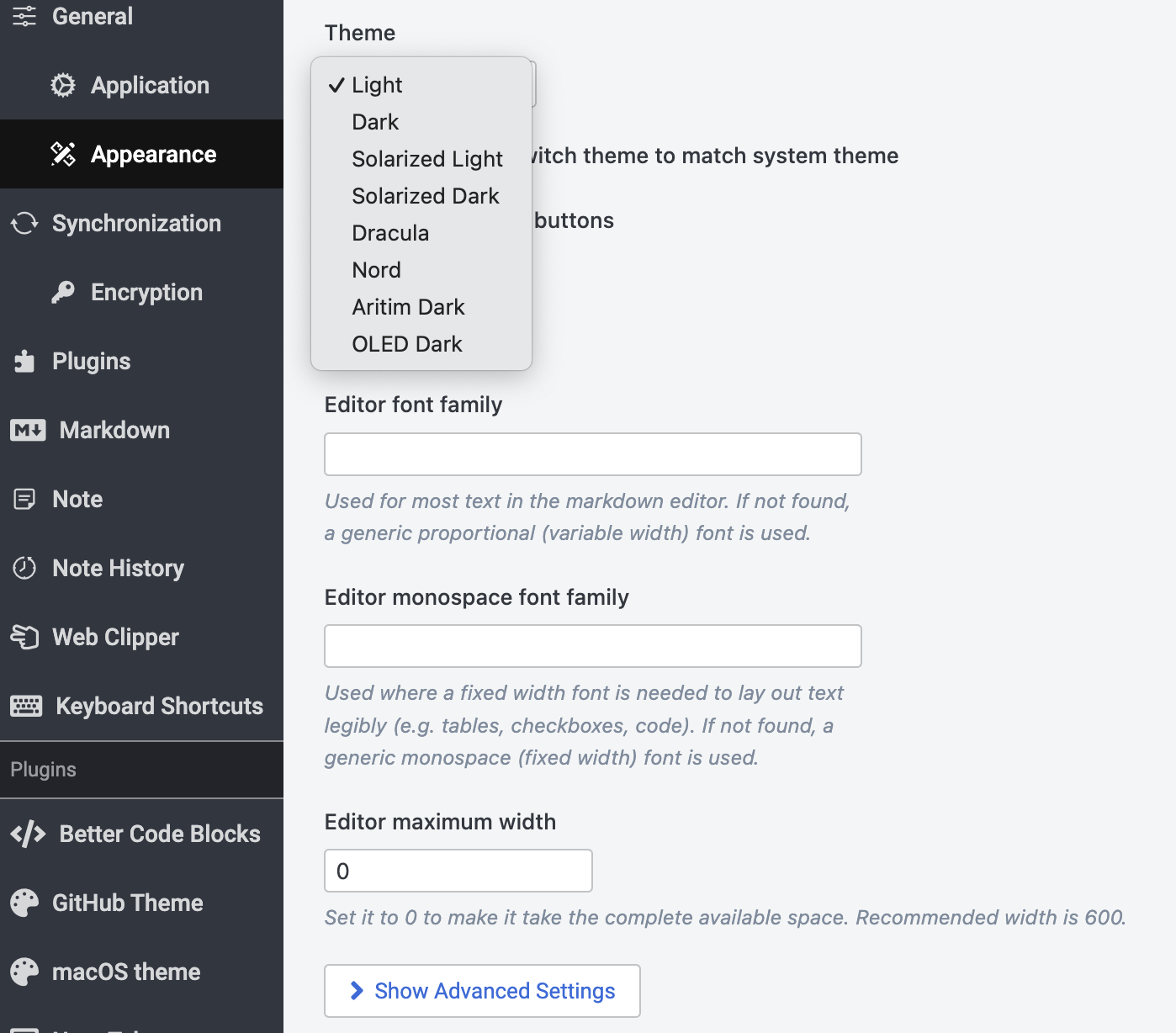
But you can also find themes for Joplin on the plugin site. Each will have it’s own settings. I found I liked the macOs theme the best.
How Do I Adjust the Layout?
This is a weird one, but when I installed the Note Tabs plugin and the Favorites plugin, they both caused the UI to go psychotic. I have deactivated Favorites. Not really sure how to use it, but I wanted the ability to open multiple notes at the same time which the Note Tabs plugin supposedly gave me.
The only problem was the tabs were on the right and were the size of the editor itself. I reactivated the Favorites plugin for an example:

The key is to go to View > Change application layout:
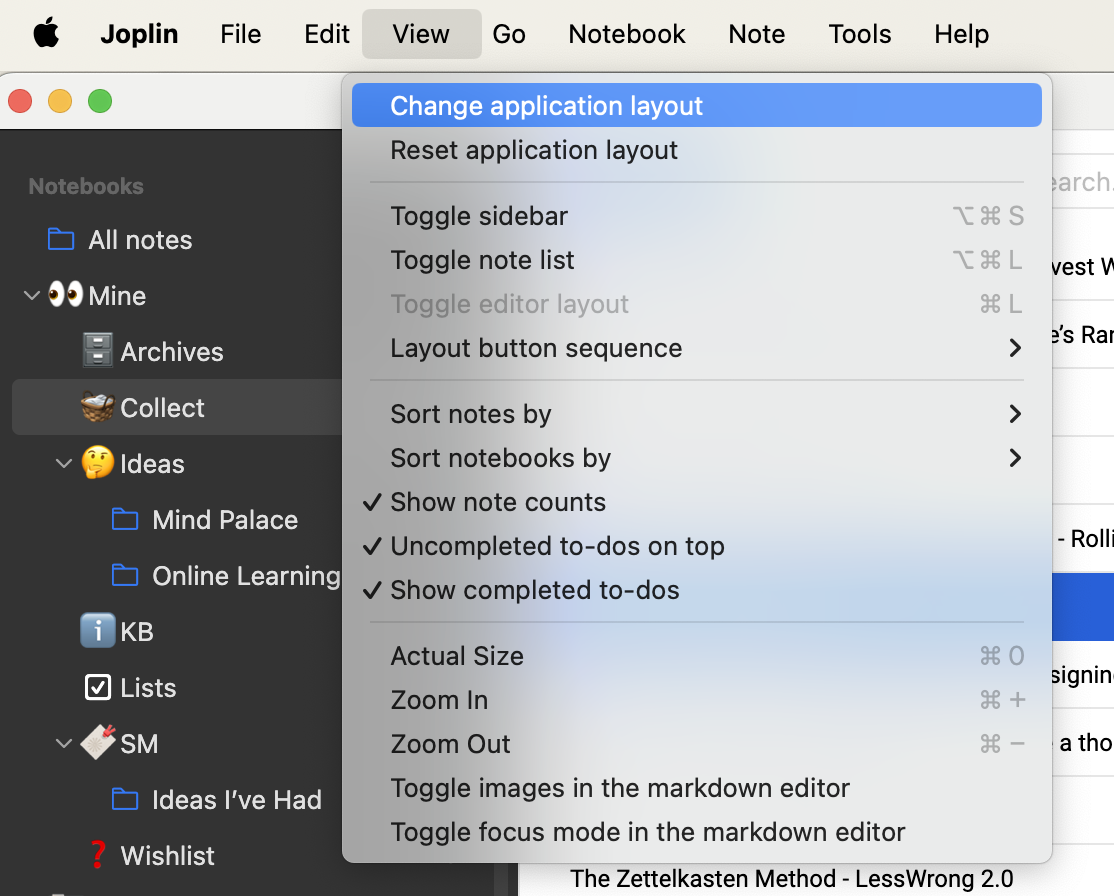
Once you click that, you will get this:
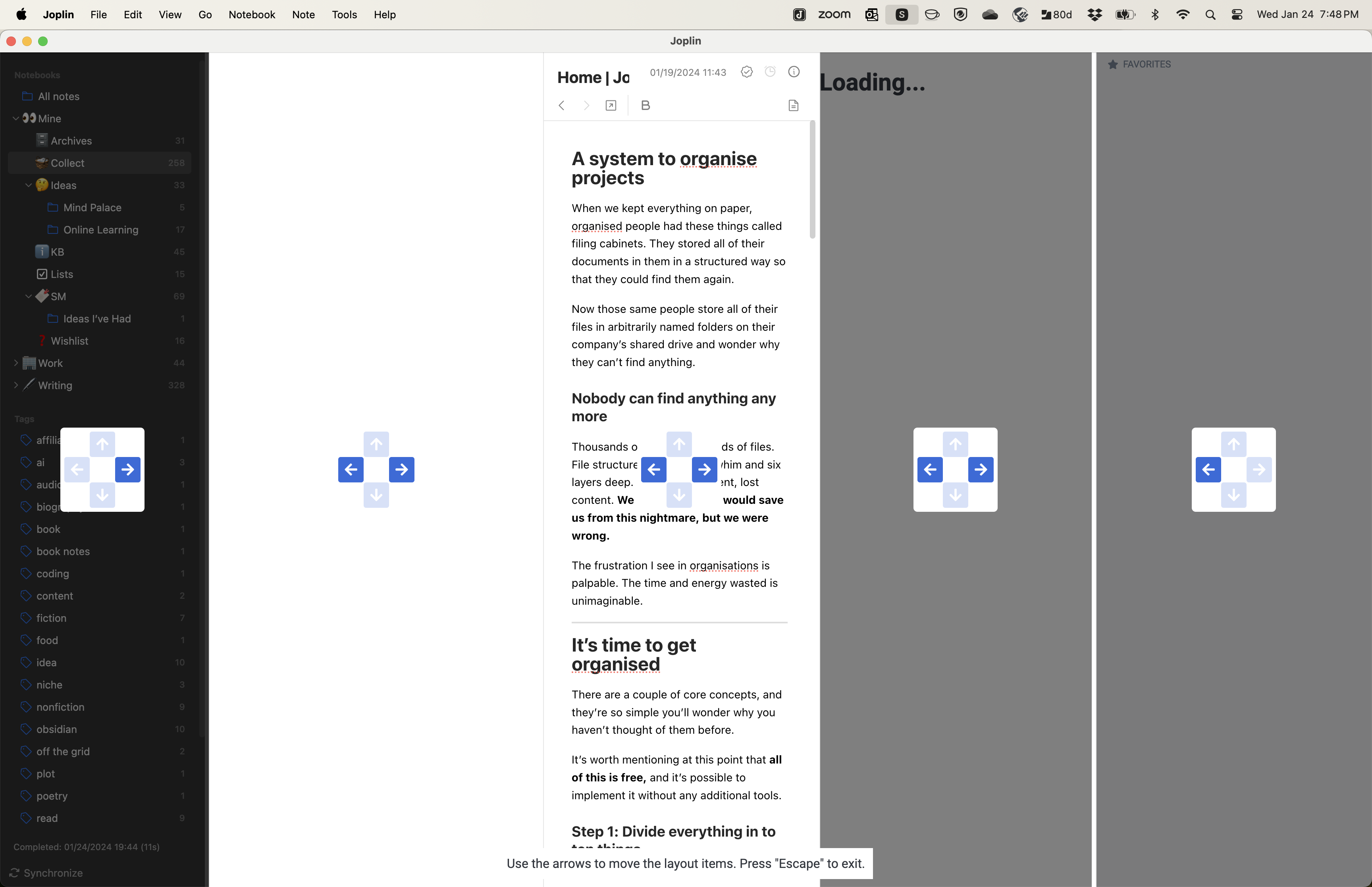
Now, I am not going to say this part is easy. It is sort of like solving a Rubik’s Cube or one of those sliding picture puzzle things. I am not even sure how to tell you how to do it, but here are some tips:
- Click the arrow buttons to move things.
- The arrow buttons sometimes don’t do what you think they will, but you will eventually get there. If it gets totally fubar, you can reset it and start over, but I didn’t have to.
- You can drag the dividers. This was the last thing I figured out after I got the tabs above the editor, but they were eight feet high. But sometimes you can’t no matter what you do. I just quit and restarted.
- Weird blocks show up. I am not even sure what they are. Like above. You can see the favorites. I have no clue what the thing to the left of them is that is
Loading.... It never showed except in this mode. So I just ignored them. - I never quite figured out how to save the layout and get out of this mode. I wasn’t sure if escaping like the message on the bottom says saved it. But quitting Joplin in this mode when I got my layout the way I wanted worked.
- Deactivating and reactivating plugins to show this example messed up my layout, so once you get it right, don’t touch it.
How I Use Joplin with Obsidian
I went back and forth. I wasn’t sure if I was going to use Joplin for this or Obsidian, but like I said, I just didn’t want to dump random things everywhere in Obsidian. I do some journaling and freewriting there, but I didn’t want it to become a junk drawer. But I needed a junk drawer, a holding and vetting area, so Joplin was it.
It turns out you can export Joplin notebooks directly into Obsidian in one step where they become a folder. Just right click on the notebook and choose Export > MD - Markdown + Front Matter.

This will turn the markdown files into a version that Obsidian can use, so when the file menu comes up, just choose where you want to put the folder in your Obsidian vault and done. But there is one caveat. If the the notebook you choose is nested, it will export the folder structure down to the folder you want like this:
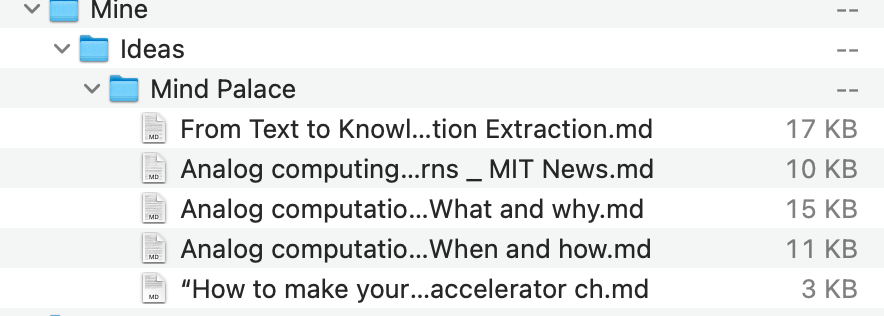
This might be what you want in some cases, but it is good to know beforehand. So if you just want the one folder without the folders above it, just drag it to the root in Joplin and then export.
How I Plan to Nip Digital Hoarding in the Bud
Doing this migration made me rethink some things. I don’t want to do something like this again. I don’t want to keep storing endless things unless I will use them. I have a habit of that:
I have tried Getting Things Done. That was way too much crap. I tried Zen to Done. It was a little better. Then I learned to stop trying to fit myself into systems and build a system around my quirks and using the concepts of those systems as needed if not the rigid structure.
This turned into a legal pad with three lists on it that I recreate weekly:
- Stuff to do this week: Daily doesn’t work for me. Yes, I have deadlines, but I only agree to write things I already know I can get done. So I just work the list linearly through the week. Get one done, pick up the next.
- Stuff to fill gaps when I am done with the first list: Or else I would go “Yay I am done” and I am never done. I would say about 75% of the time my nights are filled with writing deadlines. I get used to that after a while, but when it stops for a bit, I get sort of lost and don’t know what to do. I look at this list. “Migrating to Joplin” was here for about a year.
- Stuff to focus on when learning and researching: Or else I would go off on wild tangents. This also becomes topics that I write about too because I think learning is the best time to do so. If I hadn’t have written this article shortly after doing this migration, I would have forgot some things or got used to some weird workarounds or Joplinesque methods of doing things and leave a lot of beginners stuck because I would just assume it was common knowledge. I had “Adjust Routines” on this list for months.
This is not for my day job stuff. This is for the rest. The day job should provide you with tools you need and be kept completely separate. Don’t mix them. I write it manually every Sunday because that is my review and it takes work, so I don’t overload myself. I have the gap list. I don’t need to. And one side of one page is the rule, with the lists in the four corners.
But I’ve decided that is not enough review. I’ve added a new list called “Weekly Review” which includes:
- TODOS: Create a new page on the legal pad and throw the old one out.
- Gmail: I use this for some TODOs, mainly for stuff in motion where I am waiting on other people or when I get an email I want to respond but just not right away. I star things for this list and when I have to scroll to see the whole thing, it is time to clean. But I sort of manage this daily, so it rarely gets that bad.
- Joplin: Organize stuff that I’ve collected with Clipper. If it is something that is interesting and I don’t know where it fits yet, I add tags and move it to the KB (Knowledge Base) notebook. If I have collected notes for something I am working on in Obsidian, group them into a notebook and export them to Obsidian.
- Obsidian: Obsidian is an iceberg I am still learning how to use, but right now I have everything to do with my writing in one vault. I also have Kanban boards for articles I am writing, changes I want to make to my blog, etc. Right now this might be a simple review to make sure that everything is in order, but I will add to it.
It wasn’t until recently that I have learned to throw the proclamations of gurus out and just find a way that works for me, not just with this.
It started with writing. Every book on writing I read became “the way I need to do it”…for at least 20 years. The authors of most of these books make you think that and think you are a failure when you can’t do it. Then someone told me again that there is as many methods of writing as there are writers and each writer uses different methods for different purposes and it finally stuck. Now I see books that claim to teach me “the only way” to do a thing as an option, just another tool I can try and throw out or adjust when it doesn’t work for me.
It’s the best thing I have ever done or learned.
Conclusion: Joplin vs Evernote
This seems like a lot, but it took me less than a couple of hours in the end and if I would have stopped babysitting the sync process and just moved forward, it may have taken less time. I am happy with the change. I feel like the change made me get rid of old junk and get serious about using Joplin and Obsidian together as tools rather than digital junk drawers that I would get to eventually.
The switch is not for everyone, but I like the fact that all my notes are all in same format or at least I can move files from app to the other with a couple of clicks and if all else fails, I have all my files backed up in a readable format.
And I plan on writing some articles on Obsidian. I just have much more to say about it and it is likely to be a whole new category on my blog. And I am still learning what I can do with it.


